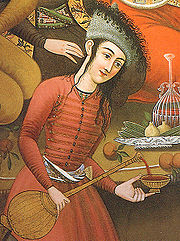
Persian wine
Encyclopedia

Persian miniature
A Persian miniature is a small painting on paper, whether a book illustration or a separate work of art intended to be kept in an album of such works called a muraqqa. The techniques are broadly comparable to the Western and Byzantine traditions of miniatures in illuminated manuscripts...
.
History of wine in Persia
Recent archaeological research has pushed back the date of the known origin of wine making in Persia far beyond that which writers earlier in the 20th century had envisaged. Excavations at the Godin TepeGodin Tepe
Godin Tepe is an archaeological site in western Iran, situated in the valley of Kangavar in Kermanshah Province. Discovered in 1961, the site was excavated from 1965 to 1973 by a Canadian expedition headed by T. Cuyler Young Jr...
site in the Zagros mountains (Badler, 1995; McGovern and Michel, 1995; McGovern, 2003), for example, have revealed pottery vessels dating from c. 3100–2900 BC which contained tartaric acid, almost certainly indicating the former presence of wine. Even earlier evidence for the existence of wine has been found at the site of Hajji Firuz Tepe
Hajji Firuz Tepe
Hajji Firuz Tepe is an archaeological site located in West Azarbaijan province in northwestern Iran. The site was excavated between 1958 and 1968 by archaeologists from the University of Pennsylvania Museum of Archaeology and Anthropology...
, also in the Zagros mountains. Here, McGovern et al. (1996) used chemical analyses of the residue of a Neolithic jar dating from as early as 5400–5000 BC to indicate high levels of tartaric acid, again suggesting that the fluid contained therein had been made from grapes . To the surprise of many, it is of note that wine's discovery in old Persia predates French wine as the earliest evidence in France only goes back to 500 BC, according to French archeologists .
Legends and myths
According to IranIran
Iran , officially the Islamic Republic of Iran , is a country in Southern and Western Asia. The name "Iran" has been in use natively since the Sassanian era and came into use internationally in 1935, before which the country was known to the Western world as Persia...
ian legend, wine was discovered by a Persian girl despondent over her rejection by the king. The girl decided to commit suicide
Suicide
Suicide is the act of intentionally causing one's own death. Suicide is often committed out of despair or attributed to some underlying mental disorder, such as depression, bipolar disorder, schizophrenia, alcoholism, or drug abuse...
by drinking the spoiled residue left by rotting table grape
Table grape
Table grapes are grapes intended for consumption while they are fresh, as opposed to grapes grown for wine production, juice production, or for drying into raisins....
s. Instead of poisoning the girl, the fermented
Fermentation (wine)
The process of fermentation in wine turns grape juice into an alcoholic beverage. During fermentation, yeast interact with sugars in the juice to create ethanol, commonly known as ethyl alcohol, and carbon dioxide...
must
Must
Must is freshly pressed fruit juice that contains the skins, seeds, and stems of the fruit. The solid portion of the must is called pomace; it typically makes up 7%–23% of the total weight of the must. Making must is the first step in winemaking...
caused her to pass out to awaken the next morning with the realization that life was worth living. She reported back to the king her discovery of the intoxicating qualities of the spoiled grape juice and was rewarded for her find.
Symbolism of wine
Within the body of Persian poetry, grapes and wine appear frequently with symbolic, metaphorical and actual meanings.Depiction of Persian wine in miniatures
Over the course of many centuries miniature painting developed into a sophisticated art of its own in Persia. In galleries and museums around the world, one witnesses Persian miniature paintings that were created in recent years. The most important element that all these paintings share is their subjects. The subjects that are mainly chosen from Hafiz’s Gazaliyat or KhayyamKhayyam
Omar Khayyam was a Persian poet, mathematician, philosopher and astronomer.Omar Khayyam or Khayyam or may also refer to:* Khayyam, Iran* Mohammed Zahur Khayyam , commonly credited as 'Khayaam', Indian music composer...
’s Rubaiyat. Therefore, the Persian wine, Mey, and Persian wine server (or cup bearer), Saghi, are the essential part of a majority of these paintings. Usually, the old man in the painting is Hafiz or Khayyam, who having left his scholarly position and books behind is now drunk in Kharabat (a mystical run down tavern that is located in a remote and poor corner of town) or in Golshan (garden) drinking wine from the hands of gorgeous Saghis.

